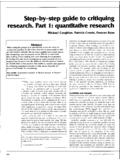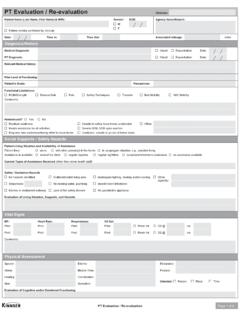Transcription of A step by step guide to - University of Oxford
1 Photo: Mim Saxl Photography A step by step guide to monitoring and evaluation 1. Credits Contents Section 1: Explanatory notes 3. This resource was Background 3. developed as part of the Using the resources 3. Project monitoring and What is monitoring and evaluation 5. evaluation for Sustainable Why do M&E 6. Communities' (http://www. Agreeing some guiding principles 6. Deciding which programmes to monitor 7. technologies/projects/. Deciding who to involve 7. monitoringandevaluation. Deciding key issues 7. html) funded by the Higher Clarifying your aims 8. Education Innovation Fund Identify information you need 10. at the University of Oxford , Deciding how to collect the information 13. and builds on ongoing work Assessing your contribution 14. undertaken as part of the Analysing and using the information 16. ongoing research project Communicating the data 17. EVALOC: Evaluating Low Ethics and data collection 17.
2 Carbon communities' project ( ). Annexes to Section 1. 1. An example of a change pathway 18. 2. Example of activity monitoring 19. 3. Examples of resilience indicators 20. 4. Examples of headline indicators 21. 5. Dealing with complex change 22. Section 2: Planning your M&E 24. A framework to help you plan your strategy for M&E. Section 3: Information collection methods 33. Internal records 33. Tracking relevant secondary information 33. Group workshops 34. monitoring and evaluation Short surveys 35. for Sustainable Communities Semi-structured interviews 36. by Section 4: Overview of resources 37. technologies/projects/. The best of what's around 37. monitoringandevaluation. Start where you are 38. html is licensed under Community and household footprinting 39. a Creative Commons Events and Surveys 41. Attribution-NonCommercial- Group processes 42. ShareAlike Unported Other online sources of information 43. License.
3 Designing survey questions 44. Group evaluation tools 44. Visual tools for discussion 46. Roles mapping 47. Discussion 48. Version Published January 2014. Section 5: Useful questions for interviews/surveys 49. 2. A step by step guide to monitoring and evaluation Introduction This resource is designed to help groups working on community led approaches to climate change and energy conduct their own monitoring and evaluation (M&E). It aims to provide an accessible background to the principles of M&E, together with selected links to resources and approaches that may be useful for your group. Background These resources were trialled at two workshops that took place in June 2013, and were attended by representatives from 25 different community groups working on energy and climate change. The workshops built on interviews with 10 community groups; a wider survey on M&E experiences and needs; and the authors own experiences of M&E through research and practical experience with and in community groups.
4 The selection of resources below responds to an identified dearth of comparable evidence across low carbon/community energy movements. While the aim is to combine ease of use with the production of useful outcomes, the list of resources is by no means exhaustive, as resources and methods are constantly evolving. Using the resources The booklet is divided into sections. Section 1 gives an overview of the approach to M&E in use, which is based on a logic model approach. Section 2 is a template for your own M&E. resources. As a pdf format, you can print this out, or type into it. You can also download the resource as a word document at: 3. Section 3 gives an overview of information collection methods, whilst section 4 provides links to a host of resources to support your M&E. Finally, section 5 contains some example questions and materials. This material is a work in progress, as during 2014 there will be further trialling of a selection of M&E tools with community groups.
5 You can read more about the project here: Thanks are extended to the groups who were interviewed for this project, who participated in the workshops, and/or gave their feedback on the resources. Thanks also to the Transition Research Network, and their Connected Communities Arts and Humanities Research Network project for the initial collaborative impetus for this project. Finally, gratitude is extended to the Transition Network, and the Low Carbon Communities Network for partnering with the project. Kersty Hobson, Ruth Mayne, Jo Hamilton December 2013. Photo: Mim Saxl Photography 4. A step by step guide to monitoring and evaluation Section 1: Explanatory notes What is monitoring and evaluation (M&E)? monitoring is the collection and analysis of information about a project or programme, undertaken while the project/programme is ongoing. evaluation is the periodic, retrospective assessment of an organisation, project or programme that might be conducted internally or by external independent evaluators.
6 A broader way of thinking about M&E is Action Research Action Research is a term for a variety of methodologies that at their core are cycles of planning, action and reflection. This is a useful approach when thinking about how to integrate your M&E into on-going plans and activities. There are many Action Research methodologies which could be used as part of your M&E. A good overview and resources can be found at the Ashridge Centre for Action Research1 Particular methods that you may find useful are Co- operative Inquiry2 and Appreciative Inquiry3. 1. Why do M&E? The first step is to be clear about why you want to do M&E and the benefits it can offer. Community volunteers and activists often want to make the world a better place, making them action-orientated and often under-resourced. monitoring and evaluation can sometimes seem like an unaffordable luxury, an administrative burden, or an unwelcome instrument of external oversight.
7 But if used well, M&E can become a powerful tool for social and political change. 1 +Centre+for+Action+Research?opendocument 2 3 5. We use the monitoring data from our household energy saving project to motivate other residents to take action. The information also helped us demonstrate the effectiveness of our approach to the local council which subsequently got funding and worked with us to set up a Community Hub to support other local communities to take action'. (Low Carbon West Oxford4 volunteer). Doing M&E can help you assess what difference you are making and can provide vital intelligence, for example to help you: assess and demonstrate your effectiveness in achieving your objectives and/or impacts on people's lives;. improve internal learning and decision making about project design, how the group operates, and implementation about success factors, barriers, which approaches work/ don't work etc;. empower and motivate volunteers and supporters.
8 Ensure accountability to key stakeholders ( your community, your members/supporters, the wider movement, funders, supporters);. influence government policy;. share learning with other communities and the wider movement;. contribute to the evidence base about effectiveness and limits of community action. 2. Agreeing some guiding principles It is useful to develop some guiding principles to ensure that your M&E is relevant, useful, timely, and credible. Some examples might include making sure the M&E and/or information you collect is: focused and feasible in relation to your available resources so that it supports rather than diverts resources from action ( make sure you focus information collection on what you need to know', not on what would be nice to know');. useful and timely information to improve group learning, group decision making, and project design;. useable by, and/or comparable to, data collected by other stakeholders so it contributes to the wider evidence base.
9 Credible, valid and reliable to the extent possible within your available resources;. sensitive to unequal power relations when you collect information ( ensure that you listen to people who might be marginalised in the community or do not have a strong voice);. ethical in relation to data consent and protection. 4 6. 3. Deciding which programmes/projects you need to monitor It is important to decide and prioritise the programmes or projects you will monitor as it is unlikely you will have the resources to monitor all your interventions at the same time. So you will need to think about which programmes or projects you want to assess; over what time period; and whether it is an on-going activity which requires monitoring or a completed activity which requires evaluation . 4. Deciding who to involve in the different stages of your M&E. To ensure M & E is relevant to your stakeholders it is important that you consider their information needs, as well as your own.
10 You will therefore need to identify the key internal and external stakeholders, and decide how to involve them in the design, implementation, analysis and/or communication of findings. Examples of people you might want to include are (a) people directly involved in your projects (b) stakeholders in your wider community (geographic or community of interest) such as specific groups of residents, specific networks, community groups, the wider movement, and/or (c) external stakeholders funders, local and national policy makers. It might also be possible to work in partnership University departments. For useful background information about working with University researchers, see the Transition Research Network5 , and the Transition Research Primer6. 5. Deciding the key issues and questions you will want to investigate The next key step is to identify the issues and questions you wish to learn about, and hence monitor.






